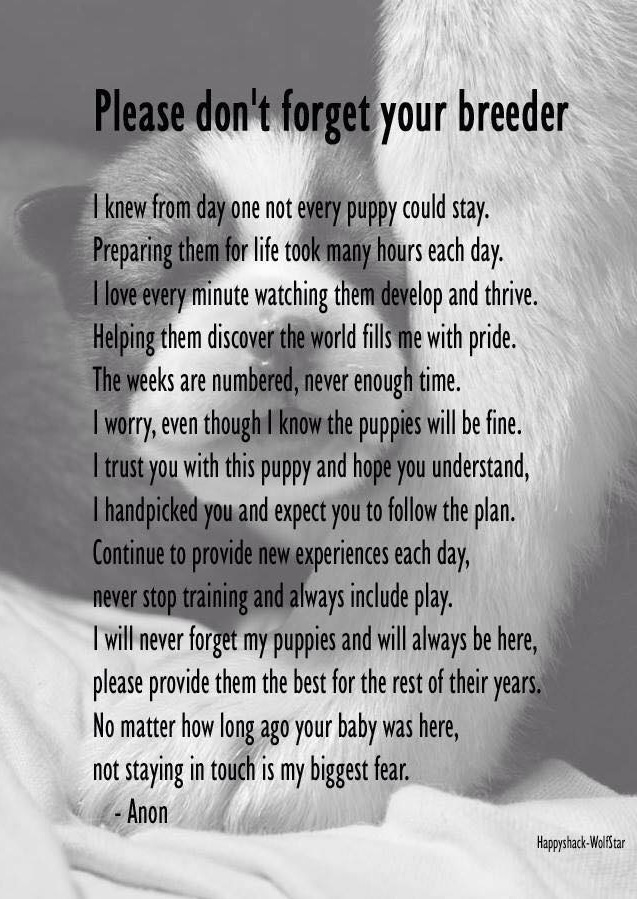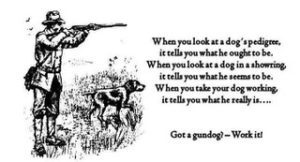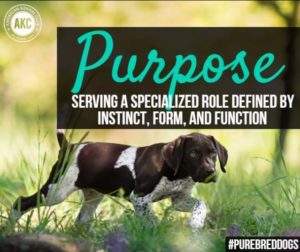Standards were written *by sportsmen*, not bench enthusiasts.
“Standards” of physical perfection exist for other domestic animals,
too, not just dogs. Horses, cattle, goats, sheep, fowl, and other livestock
also are bred to particular “standards” of conformation. Dog shows,
in fact, were originally not unlike livestock shows with the intent of breeders
showing off their stock and getting a chance to see the work of other breeders
in order to breed a better animal. In theory this is still the case. In
reality, for some fanciers, it still is. For others it goes beyond.
The reason standards exist is because as the breeds each were developed
for the specific demands of the work and terrain, they began to vary distinctly
in conformation. Certain characteristics were developed, others dropped
out, in order to best facilitate the needs and conditions of those who developed
them. That’s why we have so many different kinds of sight hounds, different
kinds of herding dogs, different kinds of scent hounds, different kinds
of spaniels, different kinds of retrievers, etc. The sportsmen who wrote
the standards did so based on their (frankly, more knowledgeable than ours)
understanding of locomotion as it relates to horses (thus the similarities
in terminology) in order to give a written blueprint to assist other breeders
in the goal towards breeding the animal considered physically superior to
perform the job.
Standards are not a modern convention. Written documentation for some breeds
goes back thousands of years.
Breed splits occur when form and function are no longer treated with equal
consideration.
In some breeds, breeding strictly for show (in theory, to the Standard)
has in some cases resulted in dogs that have gone beyond the standard to
a caricature of what the standard calls for. How does this happen? It’s
the “more is better” mentality. An obvious case: “Coat looks
good, the judges reward coat, so more must be better”. This not only
leads to more length, but, more importantly, more volume, which is the real
problem. More volume is accomplished often at the expense of proper texture
which in turn means the coat requires more maintenance. Thus the very valid
field enthusiasts’ complaint that show breds have too much coat.
As show breeders’ eye becomes accustomed to seeking out and perfecting what
they consider the most desireable aspects of type, which make the dog look
more eyecatching (and which may or may not directly relate to function),
they become oblivious to the subtle changes and deviations from the standard
occuring in the breed over time. Worse yet, they start to overlook what
are frankly faults of conformation with the rationalization that the dog
looks attractive and can trot well around the ring so “it must be ok”.
All the while, these dogs are never put to the true test…..real working
conditions. Trotting will show off most faults of locomotion, which is why
it is the preferred gait for judging. But it does not show the whole picture.
Dogs lacking in essential, function-related elements of type or soundness
won’t show this in the kind of work that is brief such as hunt tests or
even trials. Even weekend hunting dogs are not too terribly affected by
their physical deficiencies or excesses. Things like straight shoulders
that are so often forgiven in the ring, the excess coat, the lack of forechest,
whatever, show their true relevance when the dog is required to put in long
hours afield in demanding conditions doing what it was bred to do.
Instinct in show breeding is largely ignored and while some lines may retain
very strong instinct/drive for work, other lines may be weak. Thus the variance
in ability. This also varies from breed to breed. Some breeds have done
a much much better job of maintaining both good type and working ability
than others.
And what of trials? Trials today are not the same game they were at the
turn of the century. They were at one time much more geared to displaying
hunting ability. Today, in some breeds, judges are setting up scenarios
very unlikely in real hunting, upping the ante. In others, they are seeking
flashier work (and perhaps giving some aspects of hunting ability less attention).
The requirements are more exacting and the competition better trained. Breeders
for trials strive for more intense, sharper, bolder, faster animals, (“more
is better…”) which, on the surface, sounds great, doesn’t it? But
trials are not judged entirely on work. A judge is naturally, being human,
inclined to look more favorably on the dog that does his job with lots of
hard driving speed and animation (style) over the dog that works in a more
moderate, plainer manner (showier action catches the eye…..). So trial
breeders are naturally going to breed for more and more of that eyecatching
action. Sometimes, maybe often, this produces dogs that have more energy
and style than the average hunter needs or wants.
And what about the Standard as it applies to trial dogs?
Some trial dogs are so “off” standard they do not even resemble
their breed. If they aren’t built like their breed dictates, do they still
work the way they were intended to work? Does the long and low, Sussex-like
Springer work in the same manner as the tall, leggy, pointer-like one, or
the same as the proper, compact and square one? Common sense says this is
not possible.
Trialing of Spaniels is often done in grassy fields where the taller, leggier,
wider running dog will do better. Spaniels were not originally designed
soley for this function. They were all designed to work close and bust cover.
Indeed I have heard complaint time and again – by Springer trialers – of
some of these whippety looking trial Springers being “cover-shy”.
Could this be because penetrating low dense cover is that much more of an
effort for a dog so high off the ground?
What about those pint sized pointers we often hear about?
Isn’t there something wrong when the only way you can tell a large, leggy,
whippety trial-bred Springer from one of those pint-sized Pointers is that
the Springer’s tail is docked?!
How about soundness in trial dogs?
Trialers will insist that their dogs are obviously sound or they could not
do the work. Not true. Health problems such as hip dysplaysia are not always
evident in a dog, and often even if there is discomfort, a dog with lots
of heart will do excellent work despite it. We’ve all seen dogs that have
injured themselves, sometimes severely, yet continue on as if nothing has
happened. Yes, that kind of working attitude is admirable, but is it fair
to the dog?
A common example of unsoundness in field bred dogs, the thing show people
love to point their finger at, is the fiddle front/bow front — the frequently
overly broad chest accommanied by forelegs that arch out and in, usually
with the toes pointing out. This will not affect the dog in the short haul,
true. It will carry him thru hours of work in tough conditions over several
years of his life, long enough to earn his Field Trial Championship, but
as that dog ages, the result shows itself in arthritis. Such a front puts
considerable stress on the joints. Straight forelegs minimize this stress.
That’s why *all* the breed standards in any working breed of dog (and that’s
most breeds) calls for legs that come straight down under the dog.
I recall a case that clearly illustrates the necessity for soundness. A
few years back while out hunting I ran across a Brittany and his owner coming
towards me on the path. At first glance I supposed this dog was a recovering
victim from some accident. He had a funny, sidewise, gimpy sort of movement.
As we got closer I noticed this dog was severely bow fronted, very weak
in the rear, very straight stifled, and sidewinded so badly he appeared
to move sideways. He was trotting (or what appeared to be trotting…..)
at a slow pace, with some effort, in front of his owner. It was painful
to look at him move, yet I couldn’t take my eyes off him. In the course
of conversation I learned the dog was only about 5 years old, out of pure
trial stock from the grandparents on back. His owner was clearly proud of
the dog’s breeding and insistent that he was a super hunter but that he
was slowing down since he was “getting old”.
In comparison while my oldest dogs (show and field breds) are now 8, 8 1/2,
and 9 1/2 years old, they are sound and fairly well balanced, still running
with the youngsters with high energy, agility, and enthusiasm. None look
their age and only I have been able to detect the subtle changes in their
work indicating the affect their advancing age is having on them. My first
dog was probably the soundest and most balanced of the lot. She looked and
acted like a puppy until the age of about 10 or 11 when her hearing and
vision started to faulter. She was put down at 13 for internal problems.
But her running gear was completely and painlessly functional to the end.
Changes in the Standard?
There is often concern voiced amongst field enthusiasts that the breed Standards
are being altered by bench enthusiasts to favor a dog insufficiently built
for work.
Once upon a time the American Cocker Spaniel was an excellent gundog of
powerful and moderate proportions and solid reputation. It was avidly trialed.
Dual champions were made. Then around mid century a bunch of trialers got
the notion to switch to Springers and the show faction was left holding
the bag. With no field supporters, show breeders had no one on their back
to uphold the moderation needed for a working animal. Coat got longer, muzzles
got shorter. In addition, the newfound wealth following WWII allowed more
folks to get into owning and showing purebreds. Shows (and trials) became
larger, more demanding events. Others suddenly found that, not only could
they afford to own a purebred which, prior to the war was a status symbol
being affordable only by the wealthy, but that they could make money doing
it. The very temperament qualities that made the Cocker such a desireable
working dog also made it a wonderful pet and the breed came to be in demand.
Thus sprange the puppy mills and casual backyard breeders. The big Cocker
boom resulted. Other breeds followed.
The Springer story went a little differently, as I understand it, with the
show faction and the field faction taking the extremes and alienating each
other.
Field enthusiasts can have a voice. But entering the arena with guns firing
is not the way to affect change. All that does is create animosity and widen
the gap. Sheer numbers of show enthusiasts are one reason for their larger
voice. So, if field enthusiasts don’t like the way it’s going, they need
to get involved! It would help immensely for field enthusiasts to try to
understand the whole show game and the people involved in it, not make assumptions
based on limited experience or observation – or heresay. What you see going
on in Westminster is far from reality for most breeders and exhibitors.
Some aspire to that pinnacle, but a surprising number do not or are indifferent.
Many would like very much to get more involved in creating a better-rounded
dog but don’t know how or find field folk unapproachable. And many others
are simply not knowledgeable about the function of their chosen breed (as
stupid as that may sound).
You can’t tackle the whole show world in it’s huge mass. But you *can* chisel
at it, person by person 😉
Happily, quite a few show dog owners who are closet field enthusiasts are
getting out with their dogs. We have recently witnessed the American Cocker
Spaniel’s first Master Hunter. And she is a bench Champion! Could dual champions
be in the future?



